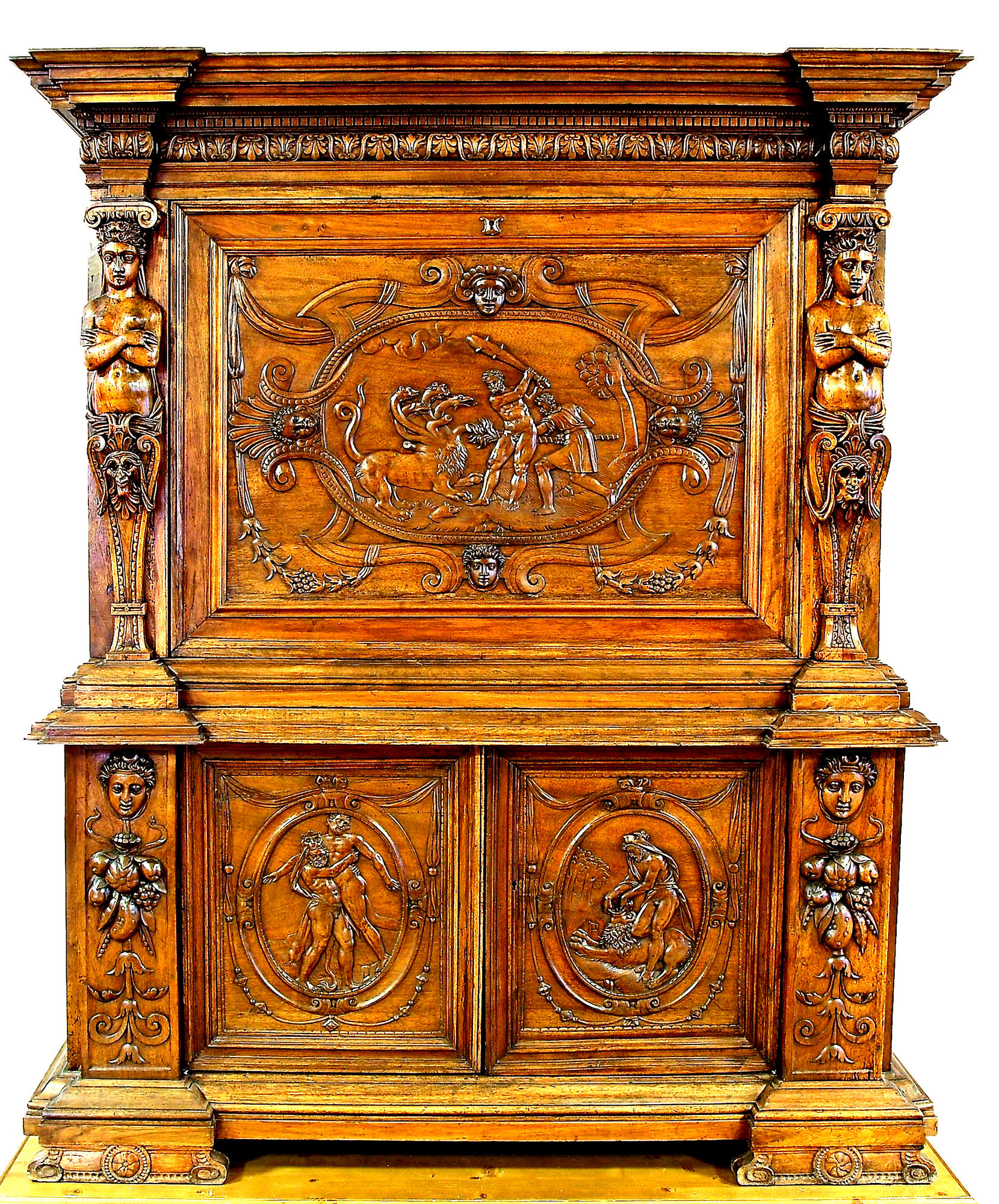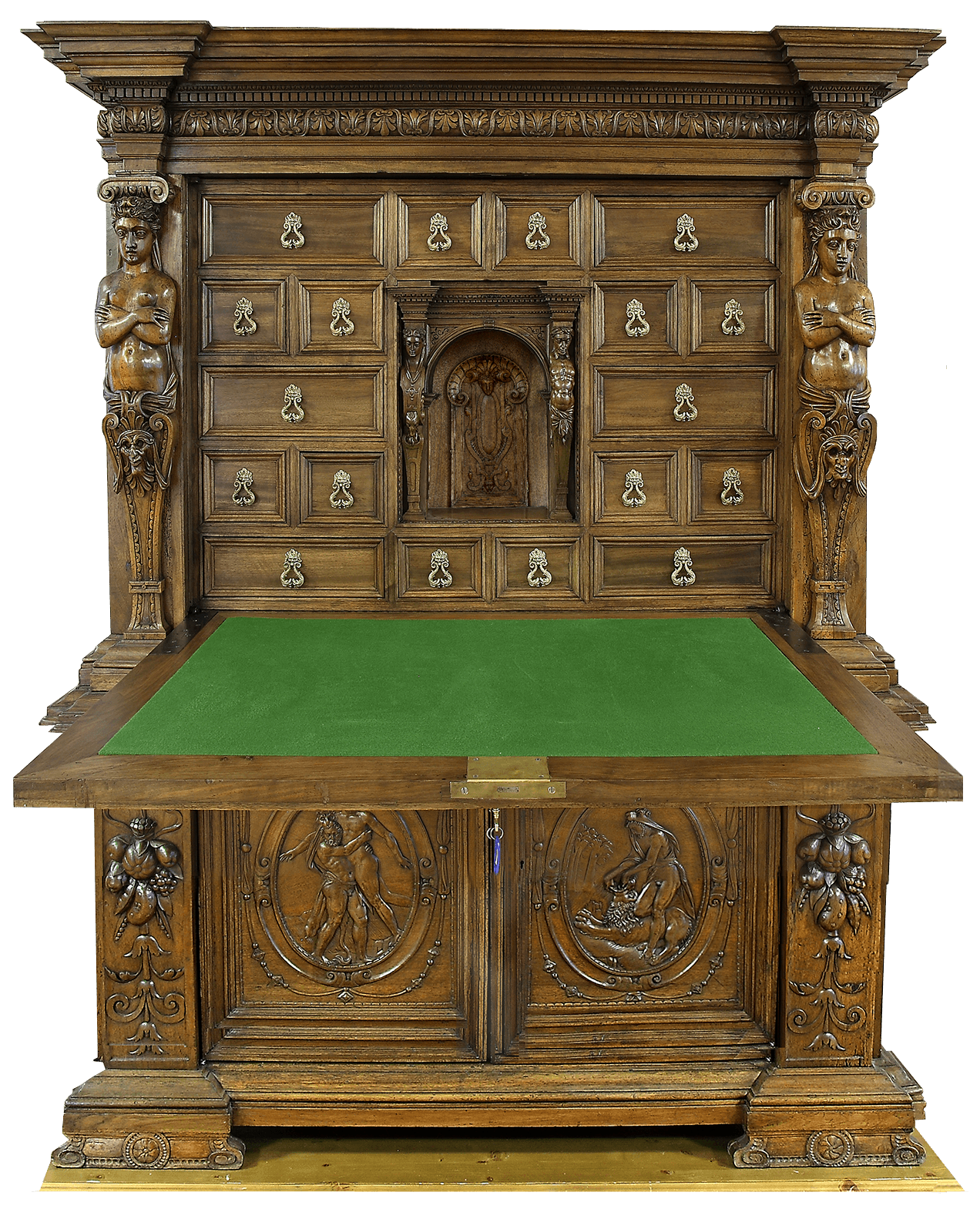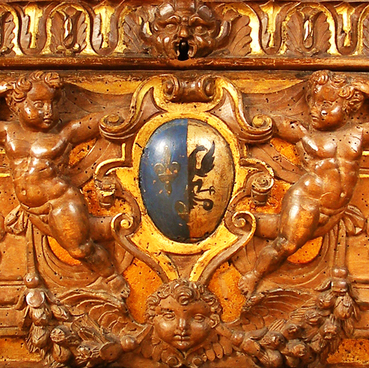he Writing Cabinet with Carved Herculean Labors was made by an unknown craftsman. Adventures of the hero were often encountered as decoration of arms and armor, but furniture makers hardly ever used that subject: therefore, this Writing Cabinet is considered rare. Most likely, the craftsman took drawings of German etchings as model: scientists came to this conclusion guided by the stylistics of the carving. So far, researches have failed to find exactly matching engravings. he Writing Cabinet with Carved Herculean Labors was made by an unknown craftsman. Adventures of the hero were often encountered as decoration of arms and armor, but furniture makers hardly ever used that subject: therefore, this Writing Cabinet is considered rare. Most likely, the craftsman took drawings of German etchings as model: scientists came to this conclusion guided by the stylistics of the carving. So far, researches have failed to find exactly matching engravings.
1 / 8
Writing Cabinet
Время создания
the 17th – 19th century
Размер
204х166х51 cm
Техника
wood, carpentry, carving
Коллекция
Выставка
4
Открыть в приложении#3
Unknown author
Writing Cabinet
#2
#4
The author showed five labors of Hercules. The hero performed them in service with King Eurystheus. In the upper part of the Writing Cabinet there is an episode from the second labor, where Hercules slayed the Lernaean Hydra. The Hydra had a body of a serpent and nine heads of a dragon. When a head was cut off, two new ones always appeared in the same place: to kill the monster, Hercules knocked off the heads with his club while his helpmate Iolaus was burning the wounds with his torch immediately thereafter. Wherever the fire touched the neck, a new head would not grow again.
#13
In the right bottom part, there is an episode of Hercules fighting the Nemean Lion. The myths describe the Lion as a monster of enormous size, its skin was as hard as steel. It was impossible to kill the monster with arrows, therefore Hercules first stunned it on the head with his club and then choked it to death.
#12
In the left bottom part, the craftsman showed the twelfth labor: in that episode Hercules got hold of apples from the Garden of Hesperides. On his way in search of the golden fruit, the warrior met Antaeus the Giant, a son of the Earth. The latter wanted to fight down Hercules, but the hero heaved him into the air: out of touch with Earth Mother, Antaeus lost his power and thus lost the fight.
The craftsman showed the sixth labor on the side of the cabinet: the cattle yard of King Augeas.
The craftsman showed the sixth labor on the side of the cabinet: the cattle yard of King Augeas.
#11
Hercules took on to cleanse, in a single day, a huge cattle yard that housed over five hundred bulls. To achieve that, he flooded the cattle yard with water of two rivers, the Alpheus and the Peneus, and the water washed away the sewage. Hercules took on to cleanse, in a single day, a huge cattle yard that housed over five hundred bulls. To achieve that, he flooded the cattle yard with water of two rivers, the Alpheus and the Peneus, and the water washed away the sewage.
The eleventh story tells about how the hero fetched up the dog Cerberus from the lower world to the world of the living.
In addition to the subjects with the Herculean deeds, there are also other decorating elements: seminude female figures, arabesque masks, bouquets of flowers and fruits. Various parts are dated from various centuries. The point is that the craftsman assembled the cabinet from fragments of other furniture that dated back to the 17th, 18th and 19th centuries. He disassembled old pieces of furniture and inserted their carved elements into his new work. This was not infrequent in late 18th – early 19th centuries, many craftsmen followed that practice.
Scientists determined that carved caryatides, i.e. columns in the form of a female figure, were made in the 17th century. There is no exact information on the other parts of the cabinet: it is only known that they were manufactured later.
The eleventh story tells about how the hero fetched up the dog Cerberus from the lower world to the world of the living.
In addition to the subjects with the Herculean deeds, there are also other decorating elements: seminude female figures, arabesque masks, bouquets of flowers and fruits. Various parts are dated from various centuries. The point is that the craftsman assembled the cabinet from fragments of other furniture that dated back to the 17th, 18th and 19th centuries. He disassembled old pieces of furniture and inserted their carved elements into his new work. This was not infrequent in late 18th – early 19th centuries, many craftsmen followed that practice.
Scientists determined that carved caryatides, i.e. columns in the form of a female figure, were made in the 17th century. There is no exact information on the other parts of the cabinet: it is only known that they were manufactured later.
#14
Yaroslavl Museum of Fine Arts
читать дальшескрыть
00:00
00:00
1x
Writing Cabinet
Время создания
the 17th – 19th century
Размер
204х166х51 cm
Техника
wood, carpentry, carving
Коллекция
Выставка
4
Открыть в приложении
Поделиться










